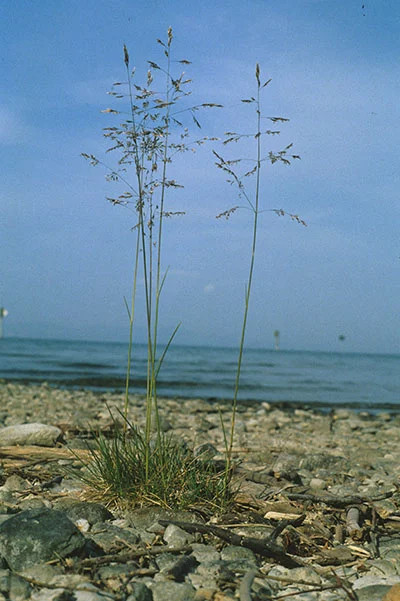Obituary of Deschampsia rhenana
Deschampsia rhenana is found only at Lake Constance- unfortunately possibly not for much longer. Because the sweet grass species is critically endangered.
Until around the year 2000, there were still large populations of the species on the shores of Lake Constance in Bavaria, but then these declined significantly and disappeared completely from 2005 onwards. In 2016, the last two specimens were found on the Bavarian shore of Lake Constance, and by 2017 these had also disappeared. On the one hand, the causes are probably the massive driftwood landings, and on the other hand in the change in flooding dynamics caused by climate change. In the warmer winters, not enough precipitation is retained as snow, so the winter drying of the shore is absent and the summer flooding is less.
Deschampsia rhenana grows in so-called beach grasses in the area of the inundation zone and is optimally adapted to the natural water level fluctuations of Lake Constance. What makes this plant unique is its ability to apparently “reproduce alive” (pseudoviviparous), it directly forms young grass plantlets on its flowers.
Currently, a project is attempting to reintroduce the species to the shores of Lake Constance in Bavaria. For this purpose, preservation cultures of the common Marram grass, also from former Bavarian areas of origin, were planted at various sites and their development is being studied.
In order to record and document the state of the Bavarian flora over time and space, as in the case of Deschampsia rhenana, the initiative “Flora of Bavaria” was founded in 2011. The aim of the project is to describe all naturally occurring vascular plants, including newly naturalized, invasive, and also extinct species, to digitally save analog information, and to make it available to the public. The working group “Flora of Bavaria”, founded by mostly volunteer plant experts, is continuously mobilizing, optimizing and expanding its data collections in order to publish a comprehensive plant atlas “Flora of Bavaria” in the next years.
In addition to the many dedicated volunteer mappers, the “Flora of Bavaria” project is supported by the Bavarian Botanical Society (BBG), the Bavarian State Office for the Environment (LfU), the Bavarian State Collection for Botany (SNSB-BSM), the Regensburg Botanical Society and the World Wildlife Fund Germany (WWF D).
The extensive data sets are archived and published centrally at the IT Center of the Bavarian Natural History Collections (SNSB IT Center). “The approximately 14 million historical and current distribution data from Bavaria currently available to us make it possible to draw conclusions about the dynamics of the decline and spread of plants. This is important for assessing the degree of endangerment of individual species more precisely and counteracting events such as the extinction of Deschampsia rhenana in Bavaria at an early stage,” explains Dr. Dagmar Triebel, head of the Biodiversity Informatics department, SNSB-BSM.
Links:
Flora von Bayern: www.bayernflora.de
SNSB IT Zentrum: http://www.snsb.info
Strand-Schmielen-Projekt: http://www.bodensee-ufer.de/Projekte/Strand-Schmiele_2016ff/strand-schmiele_2016ff.html
Contact persons:
Marcel Ruff
Botanische Staatssammlung München (SNSB-BSM)
SNSB IT Center
Koordinationsstelle zum Florenschutz in Bayern
Menzinger Straße 67, 80638 München
Tel.: 089-17861-304
E-Mail: ruff@snsb.de
Dr. Dagmar Triebel
Botanische Staatssammlung München (SNSB-BSM)
SNSB IT Center
Menzinger Straße 67, 80638 München
Tel.: 089-17861-252
E-Mail: triebel@snsb.de


